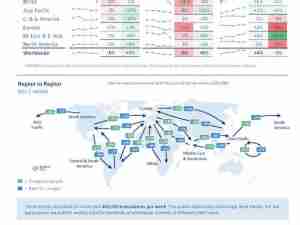JetBlue Airways Corp., stuck in its third straight year lagging the airline industry’s share returns, is looking to boost earnings by expanding in three key cities and selling more travel services such as car rentals and hotels.
The carrier will shift more flights to Boston and Fort Lauderdale, Florida, and add more seats at New York’s John F. Kennedy International Airport. It will step up efforts to improve on-time performance, which also trails the industry, while adding more seats on some planes. JetBlue is also banking on a renegotiated maintenance contract to help lower costs and improve margins.
The plan, outlined Tuesday during a half-day meeting with investors and analysts, represents a new push by the carrier to broaden revenue sources while trying to contain rising costs from pricier fuel and new and pending labor contracts. The initiatives should result in earnings per share of as much as $3 in 2020, the company said. That would top the $2.21 average of analysts’ estimates compiled by Bloomberg.
“JetBlue is doing a better job addressing cost concerns while also providing a promising revenue/earnings outlook,” said Adam Hackel, an analyst with Imperial Capital. The aircraft maintenance contract “could be instrumental in getting their costs in line with the industry.”
The shares rose about 1 percent to $19.18 at 1:49 p.m. in New York, while other airlines declined. JetBlue fell 15 percent this year through Monday, the biggest decline among major U.S. carriers except for American Airlines Group Inc. JetBlue trailed a Standard & Poor’s index of U.S. airlines last year and in 2016.
Revenue, Too
“As much as we are focused on costs, I want to make sure everyone recognizes that we know we are never done on the revenue side,” said Marty St. George, JetBlue’s executive vice president for commercial and planning.
The airline is targeting a net operating profit margin of 10 percent in 2020, up from 7.3 percent this year, and a return on invested capital of as much as 13 percent compared with 8.2 percent. JetBlue said it has achieved $171 million of savings under a previously announced program to reduce structural costs by $250 million to $300 million by 2020.
JetBlue follows larger carriers like American and United Continental Holdings Inc. in focusing growth on select cities in its network.
“In 2019 you will see us pretty aggressively redeploy aircraft across our network,” St. George said.
The growth plan for focus cities was expected, said Susan Donofrio, a Macquarie Group analyst. As for the new earnings target, investors are “digesting whether or not they think it’s achievable,” she said.
JetBlue already is taking steps to boost revenue, increasing the charge for first and second-checked bags by $5 each last month. It laid out a plan last week to offer discount prices in a new fare class with fewer frills to combat similar offerings from larger rivals. The carrier didn’t detail other changes to its fare categories, saying they will be rolled out starting next year.
Travel Services
The airline also wants to secure a greater share of travel spending by its passengers for services like hotels, insurance and car rentals. Those new products and the network changes will together add as much as $400 million in revenue by 2020, JetBlue said.
The airline will begin shedding its costly Embraer SA E190 jets in 2020, replacing them with 60 Airbus SE A220s that are more fuel efficient and able to profitably fly longer routes. It’s continuing to add seats to its A320 aircraft, an effort that won’t be completed until the second half of 2020.
Also in the Tuesday session, JetBlue said it has considered a “Junior Mint” offering that would place its premium cabin on secondary cross-country routes. The airline currently offers its premium “Mint” service on select flights.
Service across the Atlantic in the future is “absolutely on the table,” said President Joanna Geraghty.
JetBlue has trimmed 10 percent of jobs at its airline service centers to reduce spending. The carrier is seeking bids for a new passenger reservation system and reiterated its goal of holding costs to fly each seat a mile to flat to up 1 percent by 2020.






